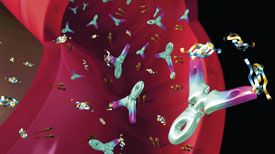Insights on Avastin: Patient Selection Is Key
The controversy over the breast cancer indication for Avastin culminated in June when the ODAC voted after an unusual and emotional 2-day hearing to uphold a prior recommendation to withdraw the label indication.

The controversy over the breast cancer indication for Avastin (bevacizumab) culminated in June when the FDA’s Oncologic Drugs Advisory Committee (ODAC) voted after an unusual and emotional 2-day hearing to uphold a prior recommendation to withdraw the label indication.
As it stands now, Avastin is approved in combination with paclitaxel for the treatment of patients who have not received chemotherapy for metastatic HER2-negative disease.
In August, Genentech put a plan the company described as a “middle-ground proposal” before the FDA under which the drug would remain in the accelerated approval program.
The company proposed revising the label to keep the drug’s breast cancer indication for use in combination with weekly paclitaxel in patients who have not received chemotherapy and whose tumors are characterized as aggressive hormone receptor (HR)-positive/HER2-negative or HR-negative/HER2- negative disease. The company also proposed a Risk Evaluation and Mitigation Strategy, or REMS.
At press time, FDA Commissioner Margaret A. Hamburg, MD, had not yet made a final decision on the ODAC recommendation.
Here are views on Avastin from 2 faculty members of the 10th International Congress on The Future of Breast Cancer.
On the Avastin Data
The front-line Avastin trials in metastatic breast cancer— three large, randomized trials—all met their primary endpoint of progression-free survival. They did not meet the endpoint of overall survival, but that wasn’t their primary endpoint. Nor were these trials really powered for survival in terms of picking up small benefits.
So, I think that the primary endpoint for approval for Avastin and other first-line therapies should be progression-free survival. I think that if you have a statistically significant finding and you meet your primary endpoint, the drug should be approved. Then it’s up to the oncology community to decide whether the magnitude of benefit is large enough to warrant the risks versus the benefits.
On the Safety of Avastin
I think Avastin in first-line therapy for metastatic breast cancer is very safe, as physicians are now accustomed to avoiding Avastin use in patients who have the possibility of complications (ie, patients with recent surgery, diverticulitis, any kind of active wound in the body, or with baseline uncontrolled hypertension).
On Using Avastin in Practice
Avastin remains my standard of care for aggressive metastatic breast cancer that requires the use of two agents for optimal control of the disease. The choice is using either two chemotherapy agents or using Taxol with Avastin. The Taxol/Avastin combination allows you to continue the treatment for metastatic breast cancer without having to decrease the dose or stop one of the drugs.
I believe Taxol/Avastin is an excellent treatment for patients with aggressive breast cancer. In the triple-negative subset of patients—many of whom are quite refractory to chemotherapy—where we have fewer options, I especially think that this is the area where Avastin fills its greatest unmet medical need.

Hope S. Rugo, MD, professor of Medicine and director of Breast Oncology and Clinical Trials Education, University of California, San Francisco Helen Diller Family Comprehensive Cancer Center
On Keeping Avastin Available
I think it should be available because a subgroup of patients benefit. I think that trying the one-size-fits-all [approach] and trying to grab the biggest piece of the pie has really not worked here.
What we need to do is say okay, if you’re going to give a weekly taxane and bevacizumab, you can treat a patient until they progress or have toxicity and then you stop. To me, the data support that approach, just as much as they support many of our new chemotherapy agents that only showed PFS benefit and had intense toxicity.
So I don’t know that this agent should be held up to a different standard.
Advice for Clinicians
First, that we’re waiting for trial results. Second, that we don’t know yet that one group of patients who will benefit more than another. But I would say that based on what we have right now, patients who have very indolent ER [estrogen receptor]-positive disease are the group of patients that are least likely to benefit from the addition of bevacizumab. But it’s not definitive.

It may be the more proliferative disease subsets that benefit more because, after all, we’re trying to treat patients who are going to have less of a duration of a response and less of a response rate to first-line chemotherapy.
I think that the data we have support first-line treatment with bevacizumab, stopping on progression, and being very careful about monitoring and managing toxicity. In terms of the partner of chemotherapy, I think that really the major data support treatment with a taxane.




